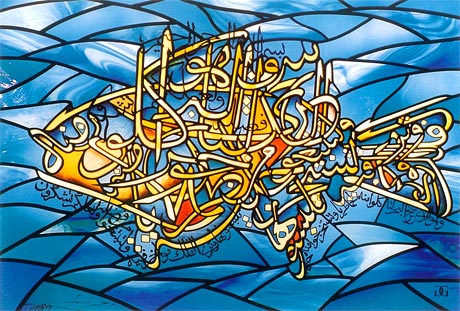
I hate HANDWRITING! Ever since the 3rd grade, teachers have complained and given me low marks for my ability to write legibly. I take notes on my computer, my hand always tenses up on those written essays… handwriting is just not my forte. For this reason I found it interesting how the written Arabic language is often most characterized by its calligraphy.
As usual, I will begin my post by going back to the Islam. It’s really interesting to see how often languages always start with religion. In my first post, I mad mention to the Hadith which were prophetic traditions passed down orally. However, some 200 years after Muhammad’s death, the Hadith was finally solidified into text by the Muslim scholar Ismail al-Bukhara. Since then, these traditions have become more heavily engraved into Islamic culture
The key language for Islam is Arabic. In fact, most Muslims believe that Arabic is the literal language in that Allah speaks in. As Muslims conquered and influenced the Arabian Peninsula, the Arabic alphabet became widely adapted and accepted as legitimate means of communication. Countries such as Iran, Pakistan, and Somalia all use the Arabic alphabet. There are often two styles of Arabic: one is more sharp and angular (derived from writing on stone) and another is more smooth and artistic.
The alphabet has 28 letters, similar to English. However, the real mind blo wer is that each of this letters can have up to four variations depending on where it is used in the word. For example, one letter would differently if it’s the first letter as compared to the same letter used at the end of a word.
wer is that each of this letters can have up to four variations depending on where it is used in the word. For example, one letter would differently if it’s the first letter as compared to the same letter used at the end of a word.
 wer is that each of this letters can have up to four variations depending on where it is used in the word. For example, one letter would differently if it’s the first letter as compared to the same letter used at the end of a word.
wer is that each of this letters can have up to four variations depending on where it is used in the word. For example, one letter would differently if it’s the first letter as compared to the same letter used at the end of a word. Anyways, there’s a brief run-down of Arabic, however, I want to draw special attention to the calligraphy of the written language. First, to understand the strong emphasis on calligraphy, it’s important to note the Quran largely influences Islamic culture. Anything in the Koran is law. In such, the Quran actually forbids the use of pictures or images to depict Islam. It’s actually considered quite disrespectful to paint portraits of the prophet Mohammad. Supposedly, pictures detract from the overall religious meaning.
In this light, Muslims drew upon calligraphy as a means of artistically expressing their religion. The written word in a unique, beautiful form conveys deep spiritual connection. Therefore, throughout history, calligraphy plays a main role in Islamic culture. Political seals were often intricate designs of religious phrases. The basmallah (praise to God) is often depicted in calligraphy. It’s amazing to me to see how individuals express their spirituality not simply by what they write, but how they write it.

The whole different variations on the same letter isn't entirely strange. In the English or Latin alphabet, we have capital and lowercase letters that each are used at certain times and to convey certain ideas and connotations in words. I wonder in history how many written languages have variations like these, or if all of them do?
ReplyDeleteOh yeah, didn't think of that. I guess our alphabet is really wierd. But still, at least we only have two forms of letters instead of 4:)
ReplyDeleteThat's a good point about capitalization or not; I didn't think about those different implications. I think it's interesting that because they felt it was sacrilegious to depict Muhammad, they decided to make his words look like art. It's like even when we have certain restrictions, people tend towards using art to show how much we value something.
ReplyDeleteI absolutely love the image of the Arabic words forming a fish. It reminded me of the scripture, "In the beginning was the word, and the word was God." I love how not only did Christ use science to create, but he also used words.
ReplyDelete